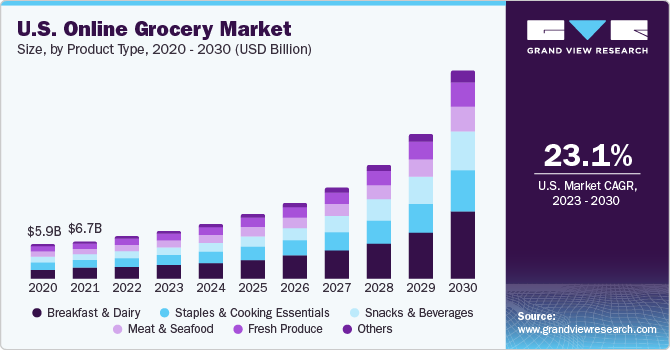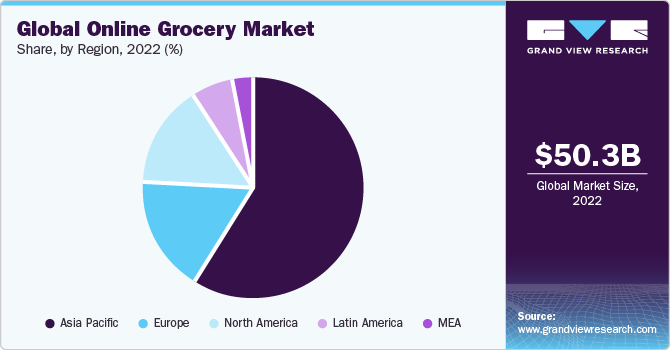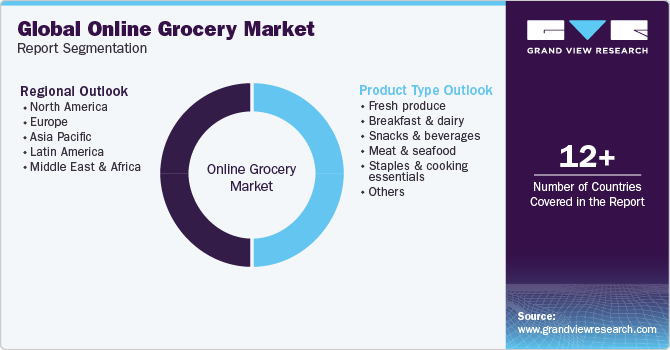- Home
- »
- Communication Services
- »
-
Online Grocery Market Size, Share & Trends Report, 2030GVR Report cover
![Online Grocery Market Size, Share & Trends Report]()
Online Grocery Market Size, Share & Trends Analysis Report By Product Type (Fresh Produce, Breakfast & Dairy, Snacks & Beverages, Staples & Cooking Essentials), By Region, And Segment Forecasts, 2023 - 2030
- Report ID: GVR-4-68038-184-9
- Number of Report Pages: 256
- Format: PDF, Horizon Databook
- Historical Range: 2018 - 2021
- Forecast Period: 2023 - 2030
- Industry: Technology
Online Grocery Market Size & Trends
The global online grocery market size was valued at USD 50.28 billion in 2022 and is anticipated to grow at a compound annual growth rate (CAGR) of 26.8% from 2023 to 2030. The changing shopping preferences of consumers in the wake of the pandemic and the unabated growth of the e-commerce industry are expected to drive the market's growth over the forecast period. The diverse options for online payments and the assurances for contactless delivery of the ordered groceries offered by online grocers are expected to contribute to the market's growth.

Technological advancements, continued urbanization, and a paradigm shift in consumers' shopping habits drive the preference for grocery shopping through online channels. Innovative business models, such as slotted or express delivery and on-demand or subscription delivery models, being introduced by grocers are also encouraging consumers to opt for online grocery shopping. Attractive discounts offered by service portals and the rising levels of disposable income also play a vital role in driving the market's growth.
Various delivery options, such as immediate or same-day delivery and click & collect are an uptrend favoring the market's growth. For instance, in the U.S., grocers offer contactless grocery delivery and fast-tracking the delivery to next-day or same-day delivery. It encourages small-scale grocers to join forces with third-party service providers, such as Instacart, and make a foray into the market. Food-delivery platforms, such as Swiggy and DoorDash, delivering online grocery is opportunistic for the growth of the market.
The pandemic outbreak has particularly driven the preference for online grocery shopping. Easy availability of time slots, lower service fees, and the convenience associated with picking up the grocery while on the way are encouraging individuals to opt for click & collect services, book the grocery online, and pick up the grocery they ordered at their convenience while avoiding crowds. As a result, grocers are rapidly building click-and-collect capabilities to ensure a convenient and robust customer experience throughout their network of groceries.
The online channel offers more options for consumers than the conventional channels. Further, e-commerce portals allow consumers to compare various products with each other and make an informed buying decision. It also allows grocers to build brand awareness while focusing on quality. In addition, features, such as saved preferences and order history for reordering, are also adding to the convenience of consumers and encouraging them to opt for online grocery shopping, thereby driving the market's growth.
Product Type Insights
The staples & cooking essentials segment accounted for the largest revenue share of around 28.0% in 2022 and is expected to expand at the fastest CAGR over the forecast period. Repetitive buying of staples, such as flour, food grains, and cooking essentials, including oil, which are considered necessities, especially in households across Asia Pacific, is fueling the market growth.
The breakfast & dairy segment is expected to expand significantly over the forecast period. The segment's growth can be attributed to the rising demand for various milk and non-milk products and the doorstep delivery of these products being facilitated by vendors. A hectic lifestyle coupled with the rising levels of disposable income is also prompting customers to order these products from online platforms rather than visiting a physical store.
Regional Insights
Asia Pacific dominated the online grocery market and accounted for the largest revenue share of 59.0% in 2022 and is expected to expand at the fastest CAGR of 29.3% over the forecast period. The regional market's growth can be attributed to the initiatives pursued by the governments of countries such as India and China to promote e-commerce and digitalization.

North America is expected to witness significant growth over the forecast period. North America is home to several key players, including Walmart, Instacart, Amazon.com, Inc., Target, and The Kroger Co. The U.S. is particularly witnessing steady growth in e-commerce sales. According to the U.S. Department of Commerce Retail Indicator Division, e-commerce sales increased 14.2% to USD 870 billion in 2021.
Key Companies & Market Share Insights
The players are undertaking strategies such as product launches, acquisitions, and collaborations to increase their global reach. For instance, in April 2022, BigBasket announced to expand its quick commerce business across India and harness the benefits of the fast-growing market. As a part of this expansion, the company projects to build 700 offline stores to cover the entire range of grocery retail.
Key Online Grocery Companies:
- AEON CO., LTD.
- Alibaba.com.
- Amazon.com, Inc.
- Blink Commerce Private Limited
- Instacart
- JD.com, Inc.
- Natures Basket Limited.
- Ebates Performance Marketing Inc.d/b/a Rakuten Rewards
- Reliance Retail.
- Supermarket Grocery Supplies Pvt. Ltd.
- Target Brands, Inc.
- Tesco.com
- The Kroger Co.
- Walmar
Recent Developments
-
In March 2022, Instacart launched "The Instacart Platform," a suite of enterprise-grade technologies designed to revolutionize the grocery industry. With this innovative offering, Instacart aims to empower retailers and enhance the consumer experience, catering to various shopping preferences.
-
In November 2021, Amazon merged its grocery stores, Fresh and Pantry, into a single unified store, Amazon Fresh. This integrated store is now accessible to customers in over 300 cities across India. By consolidating these services, Amazon aims to provide an all-in-one online destination, offering unbeatable savings, diverse products, and fast, convenient delivery options.
-
In January 2019, Walmart collaborated with four delivery companies to expand its Online Grocery Delivery service. Point Pickup, Skipcart, AxleHire, and Roadie were added to Walmart's team to enhance online grocery deliveries in metropolitan areas across four states. Furthermore, this strategic move was accompanied by expansion plans to serve even more customers in various locations.t
Online Grocery Market Report Scope
Report Attribute
Details
Market size value in 2023
USD 57.81 billion
Revenue forecast in 2030
USD 305.13 billion
Growth Rate
CAGR of 26.8% from 2023 to 2030
Base year for estimation
2022
Historical data
2018 - 2021
Forecast period
2023 - 2030
Report updated
November 2023
Quantitative units
Revenue in USD million/billion and CAGR from 2023 to 2030
Report coverage
Revenue forecast, company ranking, competitive landscape, growth factors, and trends
Segments covered
Product type, region
Regional scope
North America; Europe; Asia Pacific; Latin America; MEA
Country scope
U.S.; Canada; UK; Germany; France; China; Japan; India; Australia; South Korea; Brazil; Mexico; Saudi Arabia; South Africa; UAE
Key companies profiled
AEON CO., LTD.; Alibaba.com.; Amazon.com, Inc.; Blink Commerce Private Limited; Instacart; JD.com, Inc.; Natures Basket Limited.; Ebates Performance Marketing Inc. d/b/a Rakuten Rewards; Reliance Retail.; Supermarket Grocery Supplies Pvt Ltd; Target Brands, Inc.; Tesco.com; The Kroger Co.; Walmart
Customization scope
Free report customization (equivalent up to 8 analyst’s working days) with purchase. Addition or alteration to country, regional & segment scope
Pricing and purchase options
Avail customized purchase options to meet your exact research needs. Explore purchase options
Global Online Grocery Market Report Segmentation
This report forecasts revenue growth at global, regional, and country levels and provides an analysis of the latest industry trends in each of the sub-segments from 2018 to 2030. For this study, Grand View Research has segmented the global online grocery market report based on product type and region:

-
Product Type Outlook (Revenue, USD Billion, 2018 - 2030)
-
Fresh produce
-
Breakfast & dairy
-
Snacks & beverages
-
Meat & seafood
-
Staples & cooking essentials
-
Others
-
-
Regional Outlook (Revenue, USD Billion, 2018 - 2030)
-
North America
-
U.S.
-
Canada
-
-
Europe
-
UK
-
Germany
-
France
-
-
Asia Pacific
-
China
-
Japan
-
India
-
Australia
-
South Korea
-
-
Latin America
-
Brazil
-
Mexico
-
-
Middle East and Africa
-
Saudi Arabia
-
South Africa
-
UAE
-
-
Frequently Asked Questions About This Report
b. The global online grocery market is expected to grow at a compound annual growth rate of 26.8% from 2022 to 2030 to reach USD 305.13 billion by 2030.
b. Staples and cooking essentials segment dominated the online grocery market with a share of 27.5% in 2022. Repetitive buying of staples, such as flour, food grains, and cooking essentials, including oil, which are considered necessities, especially in households across Asia Pacific, allowed the segment to dominate the market.
b. Some key players operating in the online grocery market include AEON CO., LTD.; Alibaba.com.; Amazon.com, Inc.; Blink Commerce Private Limited; Instacart; JD.com, Inc.; Natures Basket Limited.; Ebates; Reliance Retail.; Supermarket Grocery Supplies Pvt Ltd; Target Brands, Inc.; Tesco.com; The Kroger Co.; and Walmart among others.
b. Key factors that are driving the online grocery market growth include the diverse options for online payments and the assurances for contactless delivery of the ordered groceries offered by online grocers.
b. The global online grocery market size was estimated at USD 50.28 billion in 2022 and is expected to reach USD 57.81 billion by 2023.
Share this report with your colleague or friend.
![gvr icn]()
NEED A CUSTOM REPORT?
We can customize every report - free of charge - including purchasing stand-alone sections or country-level reports, as well as offer affordable discounts for start-ups & universities. Contact us now
![Certified Icon]()
We are GDPR and CCPA compliant! Your transaction & personal information is safe and secure. For more details, please read our privacy policy.
We are committed towards customer satisfaction, and quality service.
"The quality of research they have done for us has been excellent."





